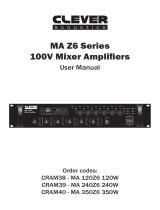953.108UK User Manual
100V line systems
For 100V line systems, connect the amplifier to the first speaker in the system using double-insulated
speaker wire which has adequate current rating to handle the total output of the DM25.
Connect the “100V” (15) output terminal to the positive (+) connection of the speaker and “COM”
output (13) to the negative (-) connection of the speaker.
Connect further speakers in parallel to the first speaker with all positive terminals and connected
together and all negative terminals connected together as shown below.
A 100V line speaker system can comprise of many speakers connected together. The determining
factor for how many speakers can be used on a single amplifier is the power rating. For most
purposes, it is advised to connect as many speakers as needed with a combined wattage of no more
than 90% of the amplifier’s output power rating.
The terminals of a 100V speaker are connected to a transformer and in some cases, this transformer
may be “tapped” for different power ratings. These tappings can be used to adjust the wattage (and
output volume) of each speaker in the system to help achieve the ideal total power of the system.
Low impedance systems
The DM25 amplifier can provide a mono output to drive low impedance speakers by connecting the
“4-16Ω” output (14) to the positive (+) speaker terminal and “COM” output (13) to the negative (-)
speaker terminal.
More than one speaker can be connected in parallel (similar to 100V speaker connection) but it is
important to ensure that the total speaker load is no less than 4Ω and that the power handling of the
speakers is equal to or greater than the shared output power of the amplifier.
Operation
When all connections to the amplifier are made, turn all rotary controls down and switch on the
power (1). Ensure a signal is being fed to the Aux input connection and gradually increase the Aux
rotary control (8) part way for checking.
Alternatively, connect a microphone to the Mic input (10) and gradually increase the Mic volume (9)
for checking. The microphone should not be able to “hear” the speakers, which can cause feedback
(squealing or howling noise).
Note: If a mic or line input is not connected to the DM25, the initial test can be made
using the built-in media player. See section below for instructions.













